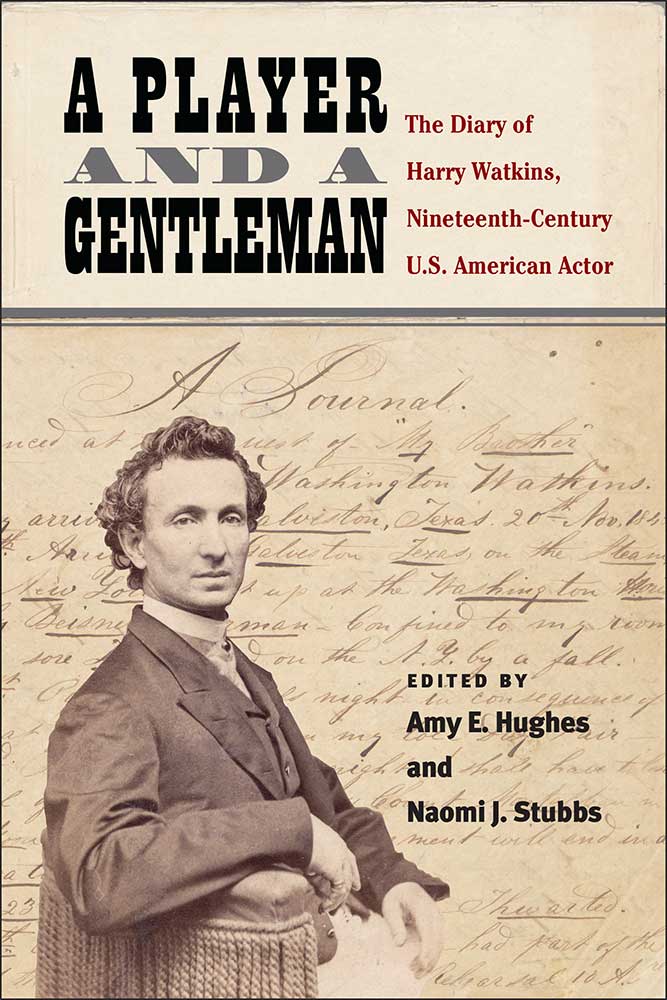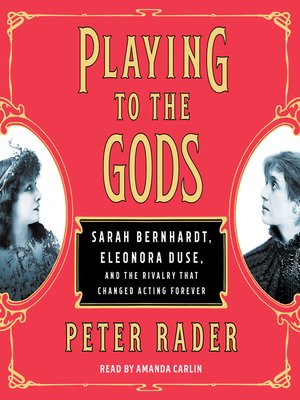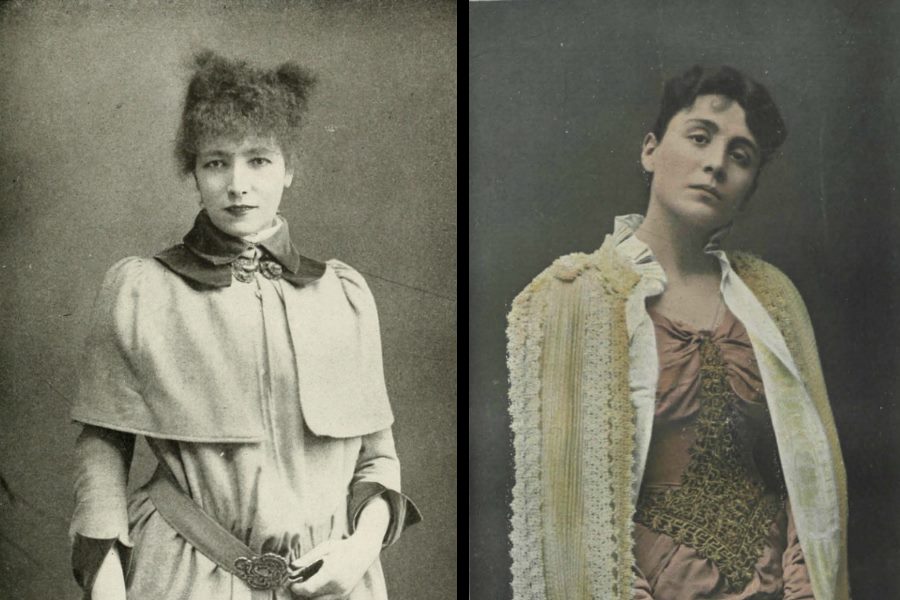Dangling between the promises of fame, fortune, and artistic fulfillment on one hand and the realities of public indifference, financial instability, and unavoidable compromise on the other, the life of an actor has always been a precarious one. And as two recent books show, that was particularly so in the 19th century. Technological advantages like the steam locomotive and gas lighting made it possible for acting companies and star performers to reach larger and more varied audiences than they ever had before. At the same time, actors and the playwrights who wrote for them began to move from productions that prized flamboyant gestures and histrionic speeches toward those that championed a more naturalistic and intimate performance style.
Edited by Amy E. Hughes and Naomi J. Stubbs, A Player and a Gentleman: The Diary of Harry Watkins, Nineteenth-Century U.S. American Actor charts those developments through the experiences of a journeyman actor who performed in the years before the Civil War. Meanwhile Peter Rader’s Playing to the Gods: Sarah Bernhardt, Eleonora Duse, and the Rivalry That Changed Acting Forever offers a dual biography of two of the greatest stars of the latter half of that century.
The Watkins book is derived from journals the actor kept from 1845—when he was a 20-year-old novice playing “walking gentleman” parts in traveling companies for $6 a week (less than $200 in today’s money, with the cost of room and board, travel expenses, and costumes eating up the bulk of that)—to 1860, when Watkins and his British-born second wife were performing plays he’d written on the London stage.

As the editors say in their introduction, “Watkins never became famous, but he always worked.” He wrote steadily too and his journals, now housed in the Harvard Theatre Collection, are considered to be the most extensive firsthand account by an American actor working during the antebellum period. The book contains about 40 percent of the full journals (a complete facsimile of which is available online) and is divided into 14 chapters, representing each of the theatrical seasons Watkins chronicled.
Every dated entry begins with a weather report, important to Watkins and his fellow performers since rain kept audiences away, as did excessive heat in the days before air conditioning or modern-day attitudes about hygiene, and if too few people turned out to see a show, actors didn’t get paid. Still, the meteorological repetition can become monotonous and the book can be eye-glazingly tedious to read when, in apparent fealty to the way Watkins wrote them, entries go on for three or four pages without paragraph breaks.
Fortunately most of the entries are bite-sized, and they all provide glimpses into the 19th-century theatrical world that academics and theatre geeks will relish. Watkins performed alongside such leading actors of his day as Junius Brutus and Edwin Booth, now better known as the father and brother of Abraham Lincoln’s assassin, John Wilkes Booth. He was in the crowds during the Astor riots when fans of British actor William Charles Macready fought with those of American actor Edwin Forrest over whose performance of Macbeth was better, with the brawl resulting in an estimated two dozen deaths. Watkins also served as a manager, the equivalent of a contemporary director, for an acting company backed by the impresario P.T. Barnum.
Theatrical brawls aside, the struggles of a 19-century actor aren’t too far-removed from that of today’s working actor. Watkins spent most of his time scrambling to find work. Finding it was often the easy part. Actors of his day had to know parts for scores of plays, from Shakespearean tragedies to farces performed in blackface, and to be ready to do as many as a dozen different ones in a week. Getting to jobs was arduous, often entailing uncomfortable travel by train, ferryboat, stagecoach, or even foot; once when a train derailed, Watkins had to swim across a river to get to a job on time.
Meanwhile, both actors and managers played fast and loose with contracts; as an actor Watkins sometimes found himself cheated out of money he’d been promised, and as a manager he struggled to keep actors in line, even once resorting to punching out a leading man. The whole business was so stressful that many actors succumbed to drink, and Watkins’ entries are dotted with references to having to prop up a drunken fellow actor onstage and attending funerals for colleagues who died at an early age from cirrhosis of the liver.
The journal details all of it, as well as the public’s preference for British stars as opposed to homegrown talents and its fickleness in supporting new plays. “The thea-tregoers of this city are constantly calling for new plays! New plays! But whenever a new play is presented a smaller number of them are in attendance than on any other occasion,” he grumbled in a lament that might as well have been written today. And yet, Watkins’ passion for the theatre rarely flags. “I have,” he wrote during his seventh year in the business, “an ardent love for my profession.”

If making it in the theatre was daunting for 19th-century men, it was even more so for women. Actresses were still fighting the stigma of being thought of as little more than courtesans. Despite that, as Rader recounts in Playing to the Gods, the French actress Sarah Bernhardt and the Italian actress Eleonora Duse became celebrated figures throughout Europe and the U.S.
Neither had an auspicious start. Duse was born to a family of street musicians and made her professional debut at the age of 4 when she was pushed onto a stage to play Cosette in an early jackleg production of Les Misérables. Bernhardt, the daughter of a high-class courtesan, used her mother’s connections to get a spot with the famed Comédie-Française, only to suffer such terrible stage fright that she was let go.
But determination and a belief in her innate gifts propelled each woman to eventual triumph, including establishing her own theatre company at a time when few women were in charge of anything. Being their own bosses allowed them to commission works that showcased their distinctive talents and secured their places in theatrical history.
Bernhardt excelled in the dramatic poses and exaggerated gestures that most 19th-century actors used to convey the emotions of their characters so that even audience members sitting far away in the cheap seats could follow what was going on. Her mastery of the technique won her devoted fans not only in her native France but in London (Oscar Wilde wrote Salome for her) and the U.S. Mark Twain raved, “There are five kinds of actresses: bad actresses, fair actresses, good actresses, great actresses—and then there is Sarah Bernhardt.”
Equally commanding offstage, the Divine Sarah, as Bernhardt’s most ardent fans called her, traveled with a menagerie of exotic animals, marketed merchandise bearing her likeness from souvenir cards to bottled drinks, gave provocative interviews about her sex life, had herself photographed sleeping in a coffin, and, during her first U.S. tour in 1880, demanded $1,000 a performance (about $25,000 today).
Duse was less flamboyant, and consequently her name may be less familiar to modern theatregoers, but Rader argues that her acting style was the more influential. Fourteen years younger than Bernhardt and more of an introvert by nature, Duse adopted a form of acting that sought to disappear within the characters she played. Thus her gestures tended to be smaller and more naturalistic than was the custom of the day. Instead she relied on the expressiveness of her face, which the newly introduced gas lighting helped illuminate.
She also fully embraced the more realistic roles being created by Ibsen and Chekhov. Shaw and Stanislavski were among her avid fans. When she performed in Moscow in 1891, Rader writes, the Russian director attended every one of her nine performances. Americans were equally smitten, even though Duse performed in Italian (Bernhardt performed in French; it seems 19-century American audiences did not consider language differences a barrier to great art). President Grover Cleveland was so taken with her that he invited her to dine at the White House, the first actor ever so honored.
But despite their acclaim, both women faced obstacles in the pursuit of their careers. Bernhardt, whose mother was Jewish, experienced anti-Semitism, which intensified when in 1899 she publicly defended Alfred Dreyfus, the French army officer of Jewish descent wrongly convicted of treason for passing military secrets to the Germans. Duse suffered from depression and bad choices in men, several of whom spent her money and left her in debt.
The relentless need to tour also forced these women to pass on the raising of their children to relatives and boarding schools, leading to estrangement or, later, overindulgence of their offspring. Bernhardt made her grown son the manager of her company, only to have him gamble away the profits. And there was the inevitability of aging. After refusing to take time off to recover fully from a leg injury she suffered in her 40s, Bernhardt had to have her leg amputated when she was 71.
Yet both women persisted. Despite her handicap, Bernhardt entertained French troops at the front during World War I and conducted a farewell tour in the U.S., choosing scenes she could perform sitting down. At the age of 58, Duse wrote and directed a movie. It was a commercial flop and so—despite ill health that restricted her performances to just twice a week— she went back on tour. The year before her death at 65, she became the first woman to appear on the cover of Time magazine.
Rader, whose credits include a biography of the journalist Mike Wallace and the script for the movie Waterworld, seems to have read every word ever written by or about the actresses and tells their stories in alternating chapters. He works hard to make the most of their contrasting acting styles and devotes a lot of space to their rival performances in Alexandre Dumas fils’s La Dame aux Camélias and as Magda, the heroine of the eponymous drama by the German playwright Hermann Sudermann, which electrified the London theatre season of 1895, when the actresses opened competing productions within days of one another.
His prose sometimes veers toward the melodramatic (“Eleanora was smitten the moment she set eyes on him,” reads the sentence about Duse’s first encounter with one of her lovers), but Rader tells a good story and an often dishy one. In scenes that might have come right out of a Ryan Murphy miniseries, he recounts the women’s affairs with the same men, including the writer Gabriele D’Annunzio, who promised to create a play for Duse but then gave it to Bernhardt. (In fact, a Hollywood director has already optioned Rader’s book.)
Two centuries have passed since Bernhardt, Duse, and Watkins strode the boards, yet these chronicles of their ups and downs would be familiar to the most dedicated actors working today. Each book is a testament to Duse’s statement that “art consumes my life.”
Janice C. Simpson directs the arts journalism program at the Craig Newmark Graduate School of Journalism at the City University of New York, writes the blog Broadway & Me, and hosts the BroadwayRadio podcast “Stagecraft.”


